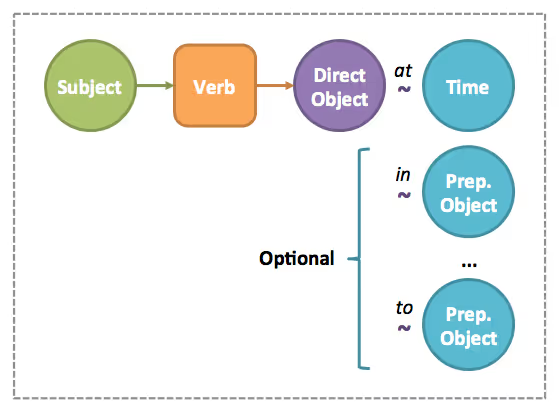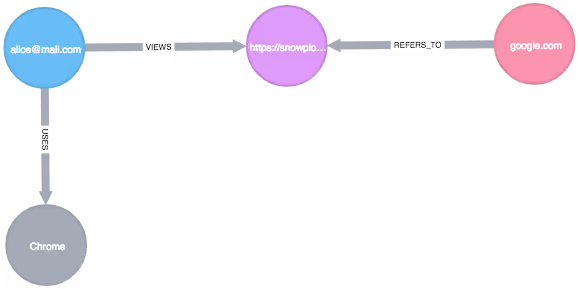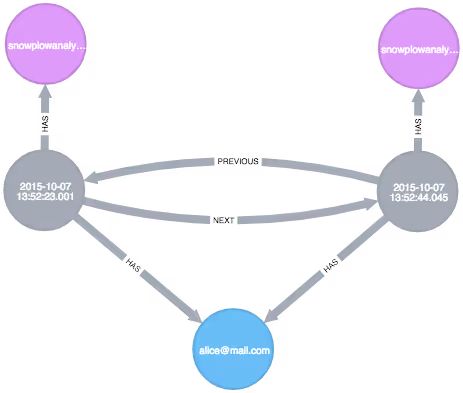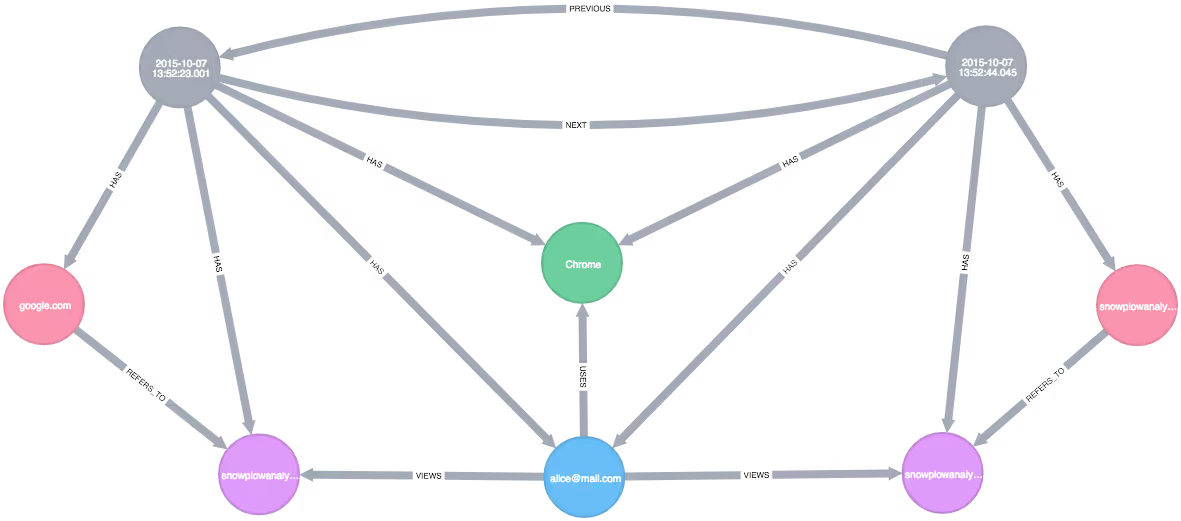Building a model for event data as a graph
In recent months we’ve been busy expanding the variety of storage targets available for Snowplow users to load Snowplow enriched events. We recently launched our Snowflake Loader, and work is underway to add support for Google’s BigQuery. Thinking even further ahead, one intriguing option is to add a graph-based storage target for Snowplow.
We’d like to take the community with us on this journey, so we will be documenting our progress in a series of blog posts over the coming weeks and months. In this post we start by exploring options for modelling event data as a graph in general. Later on, we’ll look into modelling specific events and contexts of relevant entities. We’ll also look into options for storing and querying graph event data.
In this post:
- Why graph databases?
- How do we model event data as a graph?
- Taking an event-grammar approach
- Taking a time-series or event-graph approach
- Events as nodes versus events as edges
- Do we only want to load atomic event data in a graph database?
- What should be our pilot storage target?
- The next post in the series
Why graph databases?
Graph databases have some key advantages over relational and columnar-relational databases. The way people tend to visualise concepts (on a whiteboard, say) is often already a graph; a graph database can make it easier to map business thinking to the data structures that are expected to support and underpin that thinking. By contrast, relational databases (RDBMSes) introduce a great deal of accidental complexity when translating business concepts to their tabular structure. By shortening the distance between how strategic decision-makers think and how their data teams think, graph databases can help advance Snowplow’s mission to aid companies in making better decisions.
Graph databases are also often designed for low-latency performance, even relative to query complexity. That can make them a better choice than relational databases for certain applications, such as recommendation engines, especially at scale.
There are some questions (for example path analysis) that are difficult to answer when using a relational database, but that are easy to answer with a graph. We’ve experimented with path analysis in Neo4j before.
The structure of graph databases also means that datapoints are readily extensible through the addition of new nodes and edges. For example, you could add geolocation data modelled as a graph and link it to your Snowplow enriched events by relationships that do not otherwise interfere with the enriched event’s data model. That would open up a whole new avenue for enriching the data in-database.
Adding support for a graph storage target to Snowplow could make a lot of sense. But while with RDBMSs the core data model is the same and we only have to account for the way different vendors implement that model; with graph databases there are some crucial questions that we still need to answer.
How do we model event data as a graph?
In the Snowplow event data model, as currently implemented in Redshift, Snowflake and Elasticsearch, each event is a record in a table or index. The table has as many columns or properties as there are facets to that event, eg user, timestamp, URL, etc. In the case of Redshift, some of the nested data is shredded into separate tables, some of which may have a many-to-one relationship with the “parent” event record. But the underlying model is the same - there isn’t much scope for deviation from it.
In graph databases, there are many ways event data can be modelled. One example would be to make all of the entities associated with the event nodes in the graph (user, geo-location etc), and then draw relationships between those nodes. A variant on this would be to make the event itself a node, and this “parent” node then has outgoing relationships to those same entities. It’s not obvious which model is ‘the right one’, if there even is such a thing.
Graphs excel at modelling networks – everything from social networks and product preferences to supply-chains and data lineage. You can even model and link different types of networks in an overarching graph, which is very powerful. In that environment, events would perhaps be best represented by relationships between entities in those networks.
Since graphs are so flexible, the advice is usually to build a model that suits the queries you want to run. Snowplow users come from all sorts of industries and are trying to solve a great variety of challenges. Whatever our approach, it needs to be able to accommodate that diversity.
In the sections below we look at three ways of modelling atomic event data. Each one of them could be further modified, e.g. by choosing which data points should be nodes, which ones should be edges and which ones should be properties of nodes or edges.
Taking an event-grammar approach
We’ve already done some foundational work on developing a generalised event grammar that goes some way towards a graph data model for event data. In that model, an event is a snapshot of set of entities in time, with a subject, an object, context and so on:

This model is already a graph, with nodes representing the various entities and relationships between the nodes.
In a relational database, the relationships between these entities are most often implicit: primary and foreign keys are never typed, rarely annotated and often not even enforced. A user with knowledge of the domain and the particular data model will be able to say what role each entity plays in the event and how the entities are related to each other. But in a graph, relationships are always first-class constructs. And, because relationships in graph databases are always directed, the roles of the different entities must also be explicit.
In an RDBMS, a subject and an object will be related by virtue of belonging to the same row (event). It is up to the user to decide which entity plays what role; this can cause problems when an event contains multiple entities of the same type but very different significance (e.g. player one kills player two).
In a graph, the subject and the object of the event will have to be explicitly related by a directed relationship - one that clearly indicates what role each entity plays.
In order to construct a graph, we will have to choose how to represent events as nodes and edges. To do that, it’s necessary to interpret the events. A pared-down interpretation of a Snowplow page_view event in the framework of our event grammar might look something like this:

with nodes:
(n:User) { "user_id": "alice@mail.com", "domain_userid": "fde3285a-2067-4df7-836d-991432017864" } (n:Pag
e) { "page_url": "https://live-snowplowio.pantheonsite.io" } (n:Referrer) { "page_referrer": "google.com" } (n:Browser) { "br_name": "Chrome" }
Taking a time-series or event-graph approach
A popular option for modelling events in a graph is to make each event a node that is related to the event that happened immediately before it and after it through a NEXT / PREVIOUS relationship. The event node then has outgoing HAS relationships to all of its entities, such as user nodes, context nodes, etc.

Here are the nodes in this model:
(n:Event) { "event_id": "9d718e6d-2037-41d5-82e6-4d3f73bccb81", "derived_tstamp": "2015-10-07 13:52:23.001", "event_name": "page_view" }, { "event_id": "727ca64c-5ba7-4b4f-b27a-c652a86dd7e0", "derived_tstamp": "2015-10-07 13:52:44.045", "event_name": "page_view" } (n:User) { "user_id": "alice@mail.com" } (n:Page) { "page_url": "snowplowio.site.strattic.io" }, { "page_url": "snowplowio.site.strattic.io/blog" }
This is an easy model to abstract over event data but it makes querying the data harder, because entities are related to each other only through the event node they belong to.
A variation of this model is called an event graph. In it, each event is a node and the relationships between the events imply causality. Event graphs are useful for modelling sequences of related events, like the series of events that describe a process. For example, an enter_pub event is followed by a queue event, which is followed by order_pint event, and so on. This is useful for conceptualising and simulating processes, and could be applied in use cases where we want to build a predictive model.
Events as nodes versus events as edges
The previous two examples represent two different ways of modeling an event in a graph environment. In the first case, the event is an edge (or, more correctly, an arc spanning many edges). In the second one, the event is a node.
Unlike columns, edges and relationships are created differently in the database at write time and they are also queried differently, so it’s important to make the distinction in advance.
There is also the option to “denormalise” the data, ie represent the same data in different ways. This makes queries easier, but adds complexity and redundancy to the model. An example would be a model where each event is a node in a time series, with outgoing relationships to all its entities, but there are also relationships between the entities:

This last model combines the best of both worlds. It gives us the opportunity to perform various types of queries. For example, we can easily do path analysis by traversing the NEXT / PREVIOUS edges between the Event nodes, but we can also query relationships between the entities that constitute the event.
Over the following weeks and months we’ll use this model to translate the canonical Snowplow event model (as currently used in relational databases) to a graph structure. We’ll start by modeling a page_view event in its entirety in the next post in this series.
Do we only want to load atomic event data in a graph database?
The model above provides a good framework for loading unopinionated atomic event data into a graph database - but we will also want to load modelled data. By ‘data modelling’ in this case we mean the process of using business logic to aggregate over the raw granular event data. The resulting ‘modelled’, opinionated dataset is easier to query and better suited for driving insight.
Compared to the modelling of the events themselves, with modelled data the use cases should be clearer, and the structure of the model in a graph database should emerge naturally from those use cases. We will document those experiments as part of this series as well.
What should be our pilot storage target?
While there are many exciting options in this space, such as Amazon’s recent announcement of Neptune, its cloud-native graph solution, we will be starting with Neo4j for this research and development effort. Neo4j is already widely used and its intuitive query language Cypher makes it a great choice for open-ended exploration. Its visualisation layer will help us document the journey.
This said, our philosophy is always that when people chose to use Snowplow, they do not have to be bound to specific third-party database providers. Later in the blog post series, we hope to experiment with new, vendor-agnostic and potentially in-house formats for graph-structured events on disk.
The next post in the series
Next up, we’ll look into modelling a page_view event as a ‘denormalised’ graph. We’ll take a deep dive into considerations about what data points should be nodes, relationships, labels, and properties.

